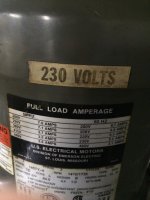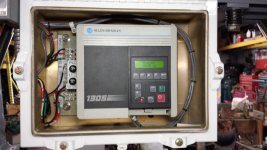jccaclimber
Stainless
- Joined
- Nov 22, 2015
- Location
- San Francisco
I've been lurking a long time but getting a Bridgeport at home made me register. Feel free to call my out on any stupid questions or forum etiquette issues. I just added a 1993 EZ Trak with as of yet unknown head issues, but the price made it worth it. This is going in my garage, so getting 240V single phase won't be an issue, but I don't have 3 phase.
1) Places I've worked that don't have 3 phase used home-made RPC's, but they were all put in place decades ago. It seems like VFD's are now the way to go, but I still see some people here using phase converters. Is this due to some benefit that only applies to shops running many machines, ie something that as a hobbyist I'm not doing?
2) VFC's are new to me, fortunately there have been lots of threads here to read about them. It seems like the one big feature is sensor less vector control. Is there anything else I should be looking out for?
3) The motor (original) is labelled as 2 hp, although there are some remarks in the manual about 3 hp intermittent use. Do I need a 3 hp VFD, or will a 2 hp VFD do? Is that a better question for the Bridgeport forum?
4) Most of the threads about which drive to select ended with a Teco (FM50/100 in old threads, N3 in new threads) or Hitachi WJ200. What I'm not getting an idea of is any notable differences (other than no vector on the FM50).
5) I'm not seeing much difference between the Teco N3 and L510. Am I missing anything obvious?
I'll be travelling for Thanksgiving, so I might be a bit slow about replying until Saturday.
1) Places I've worked that don't have 3 phase used home-made RPC's, but they were all put in place decades ago. It seems like VFD's are now the way to go, but I still see some people here using phase converters. Is this due to some benefit that only applies to shops running many machines, ie something that as a hobbyist I'm not doing?
2) VFC's are new to me, fortunately there have been lots of threads here to read about them. It seems like the one big feature is sensor less vector control. Is there anything else I should be looking out for?
3) The motor (original) is labelled as 2 hp, although there are some remarks in the manual about 3 hp intermittent use. Do I need a 3 hp VFD, or will a 2 hp VFD do? Is that a better question for the Bridgeport forum?
4) Most of the threads about which drive to select ended with a Teco (FM50/100 in old threads, N3 in new threads) or Hitachi WJ200. What I'm not getting an idea of is any notable differences (other than no vector on the FM50).
5) I'm not seeing much difference between the Teco N3 and L510. Am I missing anything obvious?
I'll be travelling for Thanksgiving, so I might be a bit slow about replying until Saturday.
Last edited:




